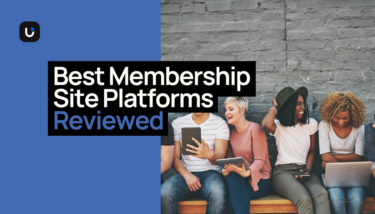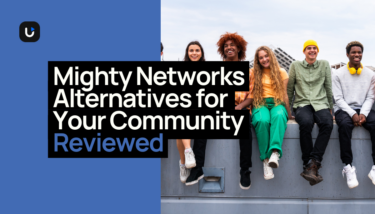Paid ads are a cost-effective way to reach your audience, increase traffic to your membership site, and drive your leads to convert.
But, your pay-per-click strategy can also lead to a high churn rate for your membership. Even though it can feel like you’re earning more money, your customer retention goes down.
So, let’s dive into what could be causing this, why it happens, and how to solve it!
The Problem With Paid Ads For Membership Businesses
In speaking to our Uscreen customers we’ve found that a lot of membership businesses rely on paid or social ads to acquire new subscribers.
For many, it’s their most consistent form of lead generation from all of their marketing efforts!
But…
This way of getting new customers also seems to lead to a high level of churn; lots of new customers come in, but just as many of them are going straight out again. So, what gives?
Well, there’s a pretty straightforward reason for this.
It’s because the ecommerce approach to paid ads – the one that’s mostly talked about on the internet or in digital marketing – is a bad fit for membership businesses.
Ecommerce products can really benefit from targeting broad audiences with a “general” interest in their product. Customers will convert with minimal exposure to content.
If you’re anything like me, you’ve ordered something from Instagram within minutes of seeing the advert and thinking, “whoa, that’s cool.”
For membership businesses, though, your audience needs a lot more exposure to your content. Potential customers need to know what they’re signing up for.
So, when you see a high amount of churn coming from your paid ads audience, it’s generally because your PPC strategy is optimized for the wrong audience.
Low-intent leads are the segment of your target audience who have barely – if ever – interacted with your brand and membership offering.
They’re unsure of what they’re getting when they sign up for your membership, so they’re likely to churn if they become members straight away.
High-intent leads, on the other hand, are the segment of your target audience who are very aware of the overall value of your membership.
They know exactly what to expect when they sign up for your membership, so they’re likely to retain if they become members straight away.
The bottom line is that if you’re applying the same PPC strategy and goals to these two unique audience segments, you’ll probably notice a high amount of churn.
Now, let’s explore how to make your paid ads work for you.
How Big is Your Paid Churn Problem?
To start, we need to look at your PPC churn rate.
Your PPC churn rate is the rate at which your paid ads audience converts, and then churns within a short period of time.
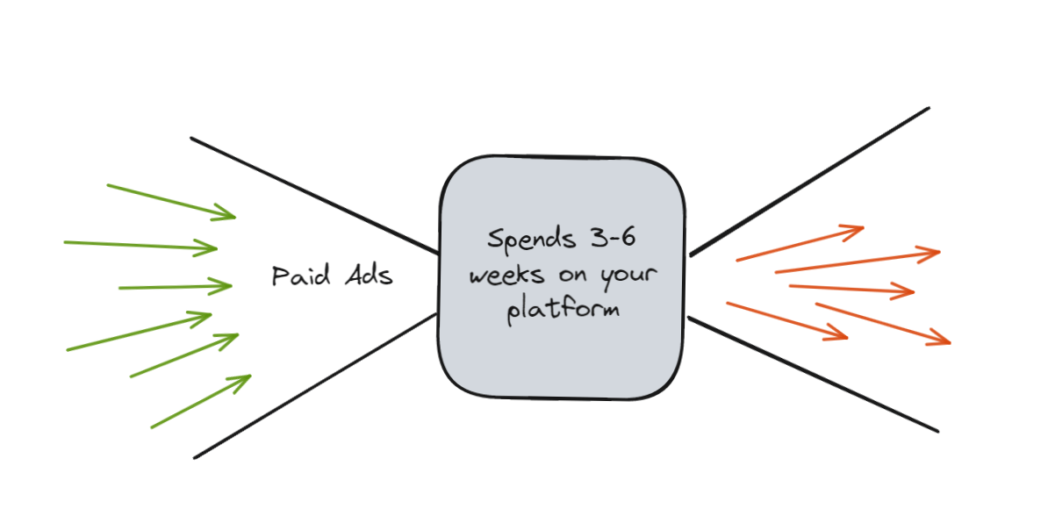
If your churn rate is too high, you end up paying more to acquire your new members than what they actually pay you throughout the duration of their membership.
A healthy CAC-to-LTV ratio for a membership business is a 2-to-1 return, meaning that for every $1 you spend on paid ads, you should be generating $2 in revenue directly from that paid ad.
If your ratio is lower than this, you need to take a look at the amount of churn coming from your paid ads conversions.
How do you work out your PPC churn rate? By using this formula:
(Total number of PPC-converted members who churned / Total number of PPC-converted members) x 100
This figure is something you need to prioritize above the other metrics that you or your marketing team are using to gauge the success of your campaigns.
Those metrics, like…
- quality score
- cost per click (CPC)
- click-through rate (CTR)
- conversion rate
…are still important, but your PPC churn rate will always have the biggest impact on your revenue.
Before we dive into the solution, let’s unpack what’s causing the problem.
Getting the Sign-Up to Stick: The PPC Churn Solution
Like every business owner, you want to balance a high conversion rate and a low churn rate.
The way to achieve this through your paid ads is to target your different audience segments with the right offer – tailored to their levels of intent – and then introduce friction.
‘Friction’ simply means that you’re adding more steps than necessary between your customer clicking on your paid ad, and them converting.
It sounds counterintuitive. Surely if you make the checkout process as streamlined as possible, it would lead to more conversions?
It would. But you’ll be converting the wrong audience who are at a high churn risk.
By introducing friction into the process, you’re essentially qualifying your new leads by weeding out the impulse buyers who only stick around for a short period of time.
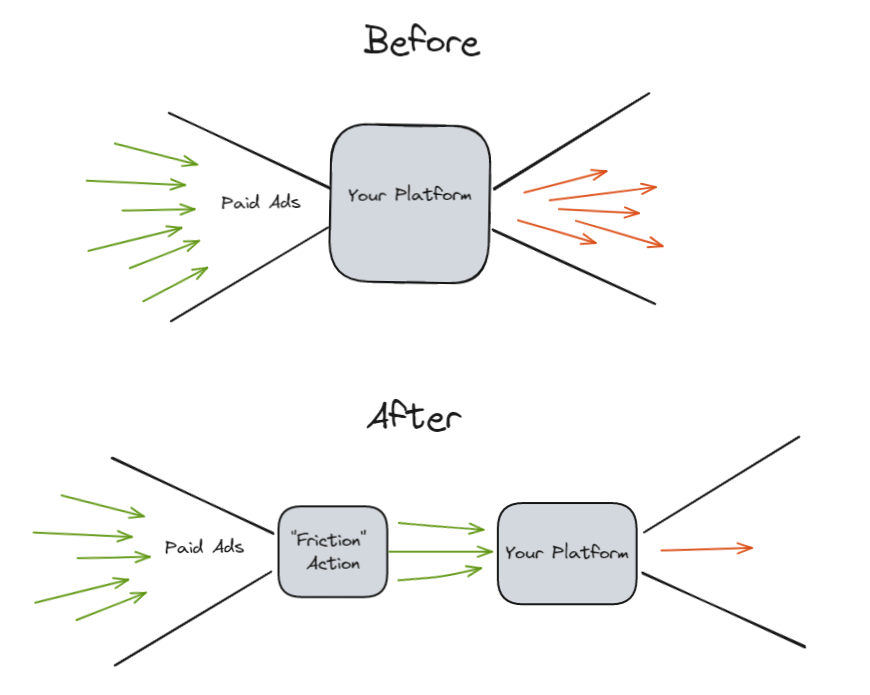
Depending on how you’ve set up your paid ads, you could have many different audience groups that you’re targeting.
But, from a zoomed-out perspective, these will all fall into one of 2 broad audience segments:
- Your low-intent audience.
- Your high-intent audience.
Let’s unpack the differences between these 2 segments, and how you should tailor your strategies to each one.
1. In Need of Nurture: Your Low-Intent Audience
This audience needs to fit your core target audience criteria. Think demographics, geographics, and niche interests.
If leads fit this criteria, it means that they’re interested in learning more about topics within your niche, but they’re still unaware of your particular membership.
Your PPC goal for this audience is to build awareness about – and demand for – your membership, without forcing them into a quick conversion.
An effective way to do this is to run a PPC campaign that directs your low-intent audience to a content marketing lead magnet of some kind.
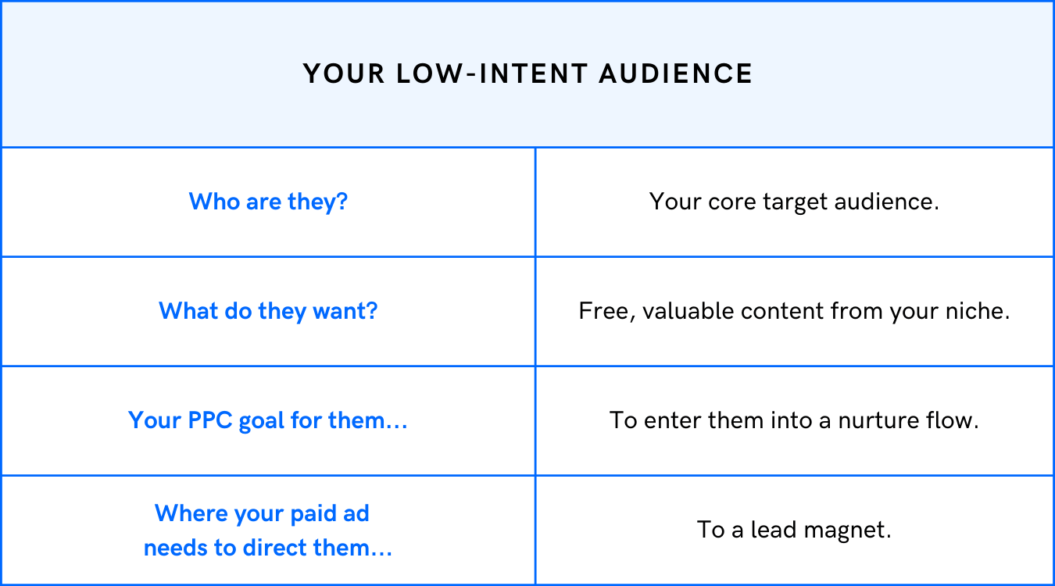
While ‘lead magnet’ sounds like a fancy term, it’s as simple as a landing page that hosts a free piece of content, which is available in exchange for the lead’s name and email address.
Why a lead magnet? It’s the perfect incentive for your low-intent leads to convert into your nurture funnel.
When it comes to which type of lead magnet to offer, many of our customers opt to provide downloadable eBooks and templates, or a free video from their premium catalog.
Here’s an example from our customer, BTRIBALFIT.
They’ve created a dedicated landing page that hosts multiple lead magnets. Having these in one place is a great customer experience, even with the increased friction.
While they’ve gone above and beyond to provide guides for the different, specific needs of their audience, you can still achieve your PPC goal with a single, valuable lead magnet.
Once you’ve captured this contact information from your low-intent leads, you can then enter them into an email nurture flow.
A good email flow should deliver content from your brand that benefits your leads in some way.
This can be achieved through educational, entertaining, and engaging content – all of which should nudge your leads to interact with your membership without telling them to convert right away.
Need a few ideas?
- Give your unique solution to a common problem within your niche.
- Share lessons that you’ve learned as an expert on an interesting topic.
- Nudge your leads to engage with your free community (like your social media following).
- Let the testimonials from your premium membership do the talking.
- Unpack the highlights of what your membership will help your leads to achieve.
Once your low-intent leads have had the chance to engage with you and learn about your membership, you can end off your nurture flow with a CTA for them to sign-up for a free-trial.
A trial will give these leads the opportunity to immerse themselves in your content and, most importantly, your community.
Like our Director of Marketing, Jaimie Chapman says: it’s easy to leave a product, it’s hard to leave a community.
Now, let’s unpack the other audience segment of your membership.
2. Set Up to Sign Up: Your High-Intent Audience
These leads go beyond just your core target audience criteria.
Your high-intent audience includes all of the standard attributes of your membership’s core audience, and has also:
- repeatedly consumed your free content
- read through all (or most) of the information on your membership
- considered signing up before
And, most importantly, they understand how valuable your membership really is.
Your PPC goal for this audience is to convert them into paying members.
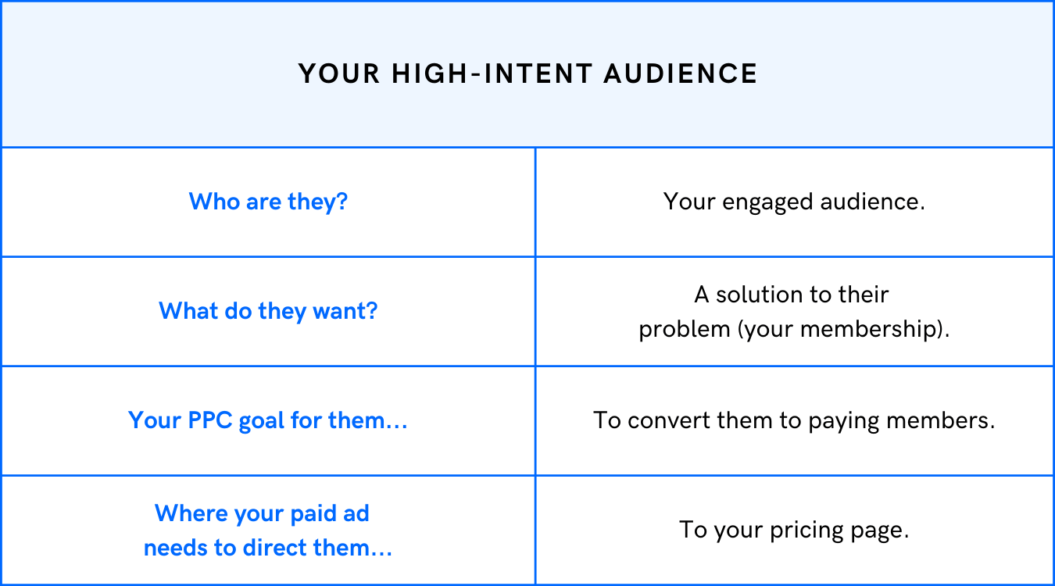
So, how can you find and target this segment with your paid ads?
First, start with your existing, high-retention members. Go figure out who they are: talk to them, and get to the bottom of why and how they realized the value of your offering.
Then double-down.
Once you’ve done your research and reworked your messaging to align with what you’ve learned, you can go out and find all of your high-intent leads.
An easy way to do this is with a little marketing tactic called, ‘retargeting’.
This is supported by most platforms where you’re running your paid ads, including:
- TikTok
These platforms allow you to add pixel tracking to your membership site, which will allow you to retarget your paid ads to everyone who visits certain pages on your website.
The best way to retarget your high-intent leads is to add your pixel tracking to pages that attract high-intent visitors.
For example, your pricing page, sign-up page, and FAQ’s page.
If you keep your tracking to these high-intent pages, you’ll avoid spending unnecessary money on retargeting just anybody who visits your homepage.
The best part about retargeting to your high-intent leads is that they’re nearly ready to convert into paying members.
That being said, you still need to introduce friction into the conversion process.
This means that your PPC campaign should direct your leads to a landing page, or your pricing page, that is optimized for conversion.
Your high-intent leads will have the opportunity to read all of the highlights about your membership, and they’ll then be able to either sign-up straight away, or sign-up for a free-trial.
Here’s another example from BTRIBALFIT, who have a great sign-up page:
Why does this sign-up page work so well?
Their information, introduction video, and testimonials all drive home the message of what their members will get when signing up.
Even though your high-intent audience has probably seen this information before, it reassures them that they know exactly what to expect before they finally convert.
You can, of course, set up your PPC campaigns in whatever way works for your membership.
As long as you’re catering to the different levels of intent across your audience – and introducing friction – you’ll be golden.
Wrapping Up…
The biggest game changer for your PPC campaigns is to break down your different audience segments and assign specific marketing goals to each one, and then introduce friction into their conversion process.
Your marketing goal for your low-intent leads will be to build brand awareness and nurture them into high-intent leads.
Your marketing goal for your high-intent leads will be to convert them into paying members.
Once your PPC campaigns have been optimized to serve these goals, your retention rates should reap the rewards.


